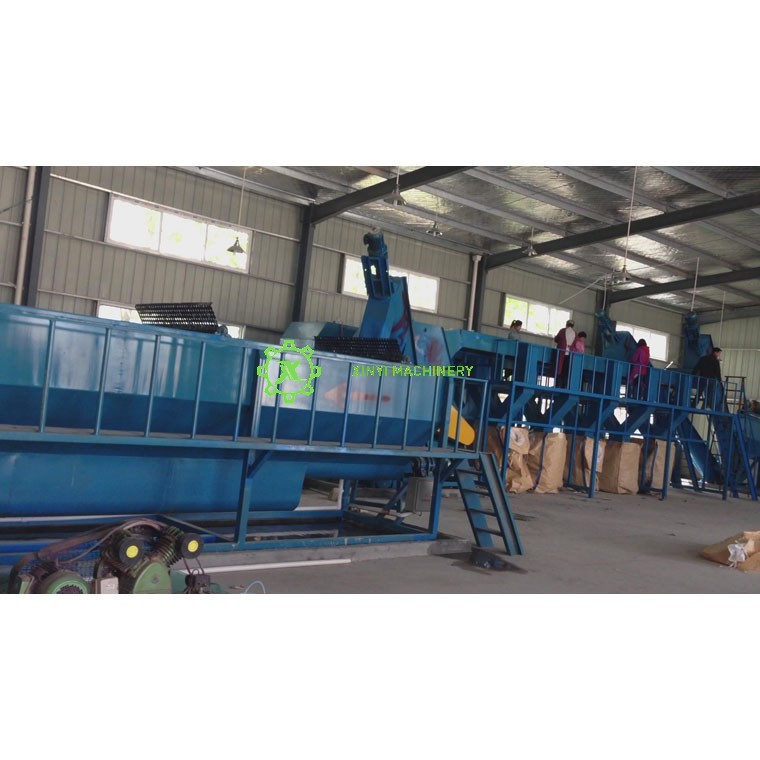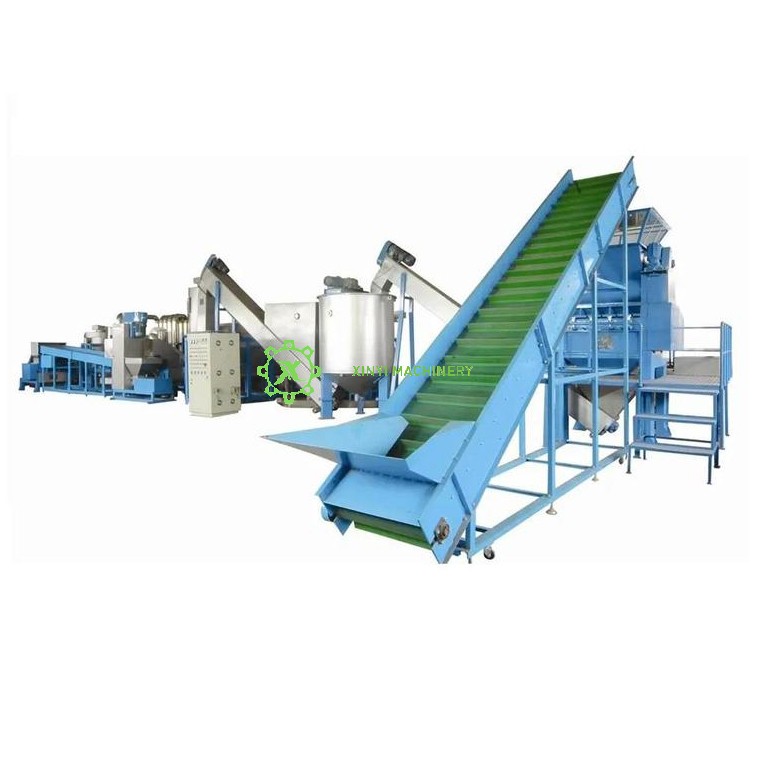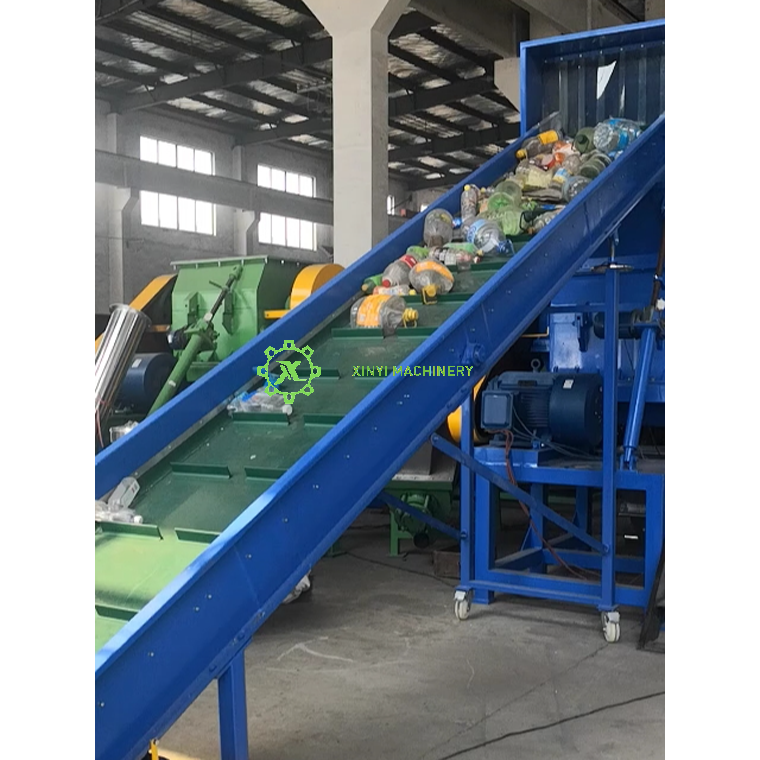A PET Water/Drink Bottle Recycling Machine Plant/Line is an integrated industrial system designed to transform discarded polyethylene terephthalate (PET) bottles (e.g., mineral water, soda, beverage containers) into high-purity recycled PET flakes or pellets. These flakes serve as raw materials for manufacturing new products like textiles, packaging, and automotive parts. Below is a detailed breakdown of its components, processes, and technical specifications:
1. Core Process Workflow
The recycling line follows a multi-stage sequence to ensure thorough decontamination and material recovery:
· Pre-Sorting & Delabeling:
o Bottles are fed via conveyor belts into a delabeling machine (剥标机), which uses rotating alloy blades to remove labels with >98% efficiency.
o Manual/Automated sorting removes non-PET contaminants (e.g., metals, PVC bottles) .
· Crushing & Separation:
o Delabeled bottles are shredded into 12–16 mm fragments using wet crushers with hydraulic feed systems, boosting efficiency by 2–5× compared to dry crushing .
o Fragments undergo sink-float separation in water tanks: PET sinks (density >1 g/cm³), while PP/PE caps float and are skimmed off .
· Washing & Purification:
o Friction washers: Mechanically scrub off adhesives and impurities .
o Thermal washing: Treated with 80–95°C water and chemicals (e.g., NaOH) to dissolve oils and bio-contaminants 38.
o Multi-stage rinsing: Eliminates residual chemicals via countercurrent water flow 6.
· Dewatering & Drying:
o Centrifugal dehydrators reduce moisture to ≤1.5% .
o Thermal dryers (e.g., pipe or hot-air systems) achieve <1% final moisture for textile-grade flakes .
⚙️ 2. Key Equipment & Technical Specs
Component | Function | Technical Highlights |
Delabeling Machine | Strips labels via abrasive blades/air jets | 99% label separation; alloy blades reduce bottle damage |
Crusher | Shreds bottles into fragments | Wet crushing (water-cooled) minimizes heat damage; output size: 12–16 mm |
Friction Washer | Scrubs fragments using high-speed rotors | Customized blade angles for PET’s friction coefficient |
Thermal Wash Tank | Heats fragments with detergents | Steam/electric heating; temperature control ±2°C |
Centrifugal Dehydrator | Spins flakes to remove surface water | Stainless steel drums; moisture reduction to 1–1.5% |
Hot-Air Dryer | Evaporates residual moisture | Closed-loop systems reuse hot air; output moisture ≤1% |
3. Capacity & Performance Metrics
· Throughput: Ranges from 200 kg/h (small-scale) to 5,000 kg/h (industrial), with 1,000 kg/h being most common .
· Resource Consumption:
o Power: 70–700 kW (e.g., 130 kW for 1,000 kg/h long-fiber grade lines) .
o Water: 0.3–10 m³/h, depending on washing stages; closed-loop systems reduce usage by 40% .
· Output Purity:
o PVC content ≤200 ppm, metals ≤20 ppm, moisture ≤1% .
o Suitable for short fibers (basic cleaning) or long fibers/textiles (intensive thermal/chemical cleaning) .
4. Customization & Sustainability Features
· Flexible Configurations:
o Cold-wash lines: For low-cost flakes (e.g., carpet fibers), using 70 kW power and 3 m³/h water .
o Hot-wash lines: For food-grade flakes, incorporating thermal boilers and alkali tanks .
· Automation & Efficiency:
o PLC-controlled systems enable 24/7 operation with only 3–5 workers per shift .
o Water recycling units filter and reuse >80% of process water, minimizing waste .
5. Economic & Operational Considerations
· Costs:
o Entry-level lines (500 kg/h): ~¥180,000 ($25,000) .
o High-capacity lines (2,000 kg/h): Up to ¥1,000,000 ($140,000)
· ROI Factors:
o Energy/water efficiency reduces operating costs by 15–30% 8.
o Flake purity determines market price (textile-grade flakes command 20–30% premiums) .
· Manufacturer Support:
o Companies like XINYI MACHINERY offer lifetime maintenance, training, and 48-hour on-site support .
Conclusion
A PET bottle recycling plant is a sophisticated, eco-industrial solution that converts plastic waste into valuable feedstock. Its design balances scalability (200–5,000 kg/h), and sustainability (closed-loop water systems). Advances in thermal washing and AI-based sorting continue to elevate output quality, positioning PET recycling as a cornerstone of the circular economy.






